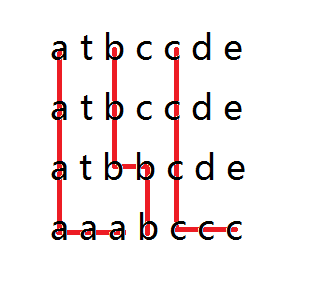首先,描出字母转移的路径,发现每个字母的转移路径都是一条折线

折线满足以下性质:
- 折线不可相交
- 折线覆盖整个T串
- 折线只能向右或向下延伸
- 一个字母转移路径上拐点个数,等于这个字母转移最少需要新开几个字符
易得,答案等于折线上拐点个数的最大值
如何求解?
使用贪心,从T串从右往左确定折线,使得折线尽量靠右。
#include<iostream> #include<cstdio> #include<cstring> using namespace std; const int N=1e6+5; char s[N],t[N]; int len,ans=0,head=1,tail=0,q[N]; int main(){ scanf("%d",&len); scanf("%s%s",s+1,t+1); if(strcmp(s+1,t+1)==0){printf("0 ");return 0;} int p=len,pos=len; while(p>0){ if(t[p-1]!=t[p]){ pos=min(pos,p); while(pos>0&&s[pos]!=t[p]) pos--; if(s[pos]!=t[p]){printf("-1 ");return 0;} while(head<=tail){ if(q[head]-(tail-head+1)+1>p) head++; else break; } q[++tail]=pos; if(p!=pos) ans=max(ans,tail-head+1); } p--; } printf("%d ",ans+1); return 0; }